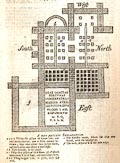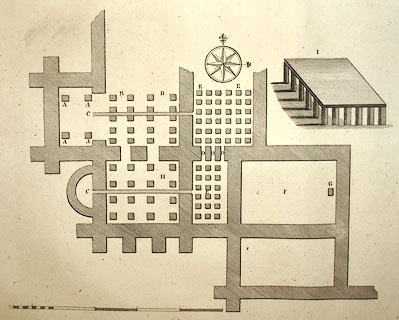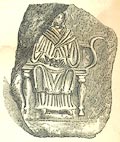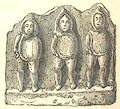




placename:- Castra Exploratorum
"CASTRA EXPLORATORUM (Site of)"
item:- inscription, roman; roman inscription; roman altar
 goto source
goto sourceGentleman's Magazine 1740 p.171 "Mr URBAN,"
"..."
 click to enlarge
click to enlargeG740E01.jpg
"THIS remarkable ALTAR to FORTUNE was lately discover'd in ye outer Room of a Bath at Netherby, it being, as Baron Clark conjectures, a peculiar Ceremony in the Worship of that Goddess, to purify the Priest and the People with Water. ..."
"The Letters are very fair, but attended with considerable Difficulty in the Reading, by means of the peculiar Signature (X) at Bottom, which the Baron says was the ancient Manner of writing M; and indeed it appears to be so from Ol. Wormius's Runic Characters. See also Hick's Antiq. literat Septentr. He therefore assigns three various Readings to it as below."
"DEAE * SANCTAE FORTUNAE CONSERVATRICI, MARCUS AURELIUS † FAVIUS TRIBUNUS ‡COHORTIS PRIMAE AELIAE HISPANORUM"
"1. MILLE EQUITUM
2. MILLIARIA EQUITATA
3. CUM MILLE EQUITIBUS"
"VOTUM SOLVIT LUBENS MERITO."
"Of these he prefers the two first, and chiefly the second."
"Mr Ward thinks it should read MILLITUM EQUESTRIUM; and, if the Baron's first Method and this be right, what a Profusion of Criticism would have been sav'd to Salmasius, Lipsius, Caufabon &c. concerning equestrian Cohorts, had this signal Stone been discovered a few Centuries sooner! ... But as the Cohors milliaria seems to be a general Name for every first Cohort, I should rather prefer the mille equitum or militum equestrium, because the Cohors prima and milliaria appear to me one of them superfluous."
"..."
"Mr Horsley conjectures that the Romans have made a Ligature of the direct and reverted C, connected with the Numeral X, for ten Hundred, or a Thousand, as thus (X) and so that Signature came in Use for mille; if so, it must admit of no other Reading but mille Equi-"
"*The Epithet Sanctae seems apply'd to this Goddess on no other of her Altars yet found in Britain."
" †Falvius I read Alvius, there being no F in the Original."
"‡This Cohort was never known to have garrison'd Netherby before this Altar was discovered."
item:- inscription, roman; roman inscription; roman altar
 goto source
goto sourceGentleman's Magazine 1740 p.172
Gents Mag 1740 p.172 "[Equi]tum: ..."
"Certainly if equestrian Cohorts were ever us'd by the Romans, the Defence of the Stations near the Frontiers, where this Cohort generally resided, seems to want such a Garrison most, for the sake of expeditious marching where hostile Attempts might call them."
"Accordingly we find the Spanish Cohort with Agricola, Vespasian's Legate, at Airdoch in Scotland; and it appears to have been about 37 Years after this Legate's Resignation, before Hadrian built his Vallum, at which Time they probably assum'd the Title AElia (attributed to them in this Stone) in Compliment to the Emperor, and might have their Quarters then at Netherby, where the Altar was found, as an advanced Station to the Wall. After this, when the Empire was on the decline, I think they have been at Ellenborough, on the Coast of Cumberland, by Inscriptions found there. See Brit. Rom. p.279. And when the Notitia was wrote, a little before the Romans abandon'd the Island, they are expressly placed at Axelodunum on the Wall, which Mr Horsley imagines to be Brugh on the Sands. Neither are any Altars yet found that mention their being elsewhere in Britain. ..."
"Those that would enquire farther into the Nature of equestrian Cohorts, may consult Brit. Rom. Ch.VI. Book.I."
"Netherby is about ten Miles North of the Wall; there are several other Pieces of Antiquity at it, but as they are already published, I shall take no farther Notice of them. Our Maps of Cumberland are strangley mistaken with respect to the Situation of Places thereabouts."
"April 12, 1740."
"G.S."
item:- hypocaust
 goto source
goto sourceGentleman's Magazine 1750 p.27 "Draught of an ancient Roman Sweating-Stove."
"Mr URBAN,"
"I Send you inclosed the draught of an Hypocaustum, or Bath, discover'd at Netherby, 10 miles north from Carlisle. You may compare it with another at Cast-steeds communicated to you (See Vol. xi. p.650, Vol. xii p.30, 31, and Vol. xvii. p..60."
"The rooms mark'd c were the sudatories, or sweating places, where the people retired after bathing. a, a were for exercise, &c. That mark'd f, a bath for ablution; a necessary part of the Heathen theology in the worship of Fortune, to whom the altar is conecrated, which is also in another part of your Magazines (See Vol. X. p.171.) The communicating funnels (b) supply'd the fire with fresh pabulum of air, and at the same time the pipes (d) heated the sudatories."
"G. SMITH."
 click to enlarge
click to enlargeG750E01.jpg
"N.B. Most of the rooms were floor'd with a small thick flag, laid in cement, with three courses of pavement below."
placename:- Netherby
placename:- Castra Exploratorum
 click to enlarge
click to enlargePEN1Cm.jpg
"NETHERBY / CAST EXPL"
circle; buildings, village, etc
item:- private collection : 66
Image © see bottom of page
item:- roman altar; altar, roman; roman inscription; inscription, roman
 goto source
goto sourcePage 195:- "..."
""Netherby is seven miles north from Cairluel and Eske river runneth on the north side of it. There hath been mervelus buildings as appeer by ruinus walls, and men alive have seen rynges and staples in the walls, as it had been stayes or holds for ships. ... The ruins be now three miles at least from the flowing water of Sulway sands. The grass groweth now on the ruins of the walls.""
"..."
"There is a gradual descent from the principal and oblong fort on the north-west angle towards the Esk, in which several streets are very visible. In one running north and south, on the west side towards the river, by digging among the ruins for stones, were discovered two rooms parallel to the street. The southernmost is plainly a cold bath, marked F in the plan, from the cement and large thin flags laid at the bottom, and an earthen pipe at the north-west corner descending from a small watercourse that runs under the other room, and a partition wall, and so below the door into the street, where may have been a common sewer. The outward room has an entrance from the street as above: the door cheeks are two large flags about seven feet high, and 20 inches broad, with holes for fastening the door, which opened into the street. In this room, marked G in the plan, was found in the beginning of October, 1732, an altar with this inscription, removed into the castle."
"DEAE SANCTAE
FORTVNAE
CONSERVATRICI
MARCVS. AVREL.
SALVIVS TRIBVN
US COH. I. AEL
HISPANORVM
∞EQ.
V. S. L. M."
"They continued to work, and Mr. Goodman sent the above account to Mr. Gale Nov. 9, 1732."
"Mr. Cay, in a letter to Mr. Gale, Dec. 12, 1732, observes that "inscriptions of the Coh. I. Hisp. have been found at Airdoch and Elenborough, but in only one of them it is styled equestris, and the commander praefectus. In the Notitia is the tribunus cohortis I. Hisp. Axeloduno, which is now fixed at no great distance from Netherby or Elenborough. We have no former instances of Aelia given to this cohort. Horsley, p.95, conjectures that it might be part of the Ala Herculea, but had he seen this inscription he would have thought otherwise. He observes, p.95, that the Notitia does not often give Cohors Equitumbut, as in many places, it seems to point out the officer's residence. I know not whther we are always to suppose the whole body under his command was in the same place. I am the more surprized we have not met with trib. coh. Equit. Among the stations per lineam valli there is none said to be commanded by a praefectus alae, which appears to have been much larger than some of those where tribunes of cohorts are placed. I therefore suppose that an equestrian cohort consisted of two alae, though it might not be common to mention them as cohorts, and perhaps the Ala I Herculea and Ala Vettonum might compose this cohort. I cannot think it improbable that some of the forces that are not mentioned in the Notitia, but in inscriptions, might be removed to the borders of Wales, where that book seems deficient. I do not determine whether Scot. xxxi. and Cumb. lxii. lxiii. relate to this equestrian cohort.""
"Mr. Gale replies, Dec. 28, that "Mr. Horsley's reasons about the Ala Herculea and Coh. I. Hisp. are not conclusive. The cohort was frequently moved, and if the letters EQ. are not on the Ardoch and two of the Elenborough inscriptions, they are on a third at the last place. A cohort of the Ala Herculea might be at Netherby within distance of Old Carlisle, or the Ala itself might have been quartered more north; for the Netherby inscription appears of older and better letter than those at Elenborough. All these circumstances make it doubtful whether this cohort was part of that Ala. By its name and country it probably came over with Hadrian, and continued here till the Romans quitted the island, frequently changing its place. It might have come with the Legio VI. Victrix, and been part of one of its Alae, as that seems to have been always employed in the north and in headquarters at York. If the legionary Alae, consisting of several cohorts of foreign auxiliaries, were equal in"
 goto source
goto sourcePage 196:- "number of men to the Legion, it is probable both the Alae contained 10 cohorts. The Ala Herculea seems to have been the Ala of a Legion, and consequently composed of several cohorts, and perhaps was the same as the Ala Gordiana, and may have changed its name under Maximian, of whom Victor says that he gave his new name to the troops. The Ala Gordiana also lay at Old Carlisle, as appears from inscriptions found there."
"... ..."
"Sir J. Clerk's description of the Netherby bath in a letter to Mr. Gale, Sept. 23, 1734:"
""This edifice consists of two rooms, which, I believe, have always been under ground; for, at this time, there are marks of steps to go down to them. The door is finished by three large stones, one at top and two on the sides, each about six feet long, with marks of bolts and hinges. Each room is about nine or ten feet square, divided from each other by a thin partition of stone, and both under the same arched roof, which the workmen broke down. The outermost served for a little temple of Fortune, and in it the altar was found with heaps of heads of different animals, particularly oxen and sheep. The inner room was a bath, and, in my opinion, rather for bathing vessels to stand in than to be filled with water: for though there is a certain cement, composed of lime and beaten bricks, which covers both the floors and walls, and is indeed very hard; I have no notion it could ever hold water. The floors of both rooms are covered with large flat stones, and under them is an aqueduct or large empty space or canal, reaching from one end of the building to the other. These floors are covered with the cement about an inch and an half thick, which, I suppose, was because the stones were too cold to stand on. I believe it might be worth our while to imitate this cement in floors underground; for it seems the beaten brick, which is not very small, served to dry up the moisture of the lime and made it bind immediately."
""The Spanish horse of the inscription could not be the northern exploratores, consequently this place could not be the Castra Exploratorum, as Mr. Horsley took it to be. I make no doubt but the true Castra Exploratorum was at Midleby and Burnswark hill in Scotland, 10 mils from Netherby; for there are three Roman camps to defend these grounds, and from the top of the hill a prospect of at least 40 miles round, as I noticed to you once before, and as was likewise observed by Mr. Gordon. I believe if poor Mr. Horsley had lived to see this altar, he would have changed his opinion about the place. I don't know why it might not have been Luguvallium rather than Carlisle. If the etymology could be admitted to be Longa Vallis, it would exactly fit the country about Netherby, which is part of what we call Eskdale or Escae Vallis. I own the next station of the Itinerary would create some difficulty, but that would be only in the distances, about which we can have but little certainty."
""From the heads of animals found in the Fanum Fortunae, we may guess the priest had picked them before they came there, otherwise the place had been a meer slaughter-house. The altar, no doubt, served for libations, or, according to the priest-craft of those times, for a small part of the viscera, while those holy men feasted on the rest themselves."
""I observed on the pavement scattered about several fragments of fine earthen pots adorned with figures. These, no doubt, have served for oils, or paterae and prefericula."
""About 30 ells in a strait line from this fabric is a spring, which, no doubt, you noticed. This has supplied the bath, and issued by the aqueduct. I shall only add, that Netherby is much the same kind of station as Midleby: for there are considerable vestiges of stone buildings in both. I believe"
 goto source
goto sourcePage 197:- "if lord Preston was spoken to he would order some of these ruins to be digged up. I myself have bespoke some workmen at Midleby.""
"Another letter of sir J. Clerk's relating to the same, Oct. 29, 1734:"
""Sir, I cannot but be satisfied with your reading of the inscription on the Netherby altar, but I still state to you my reasons for what I sent you: I know very well that the first cohort of a legion used sometimes to be called Mliliaria, for so Rosinus and Vegetius, and before them Modestus had taught me. I know it consisted both of horse and foot, but I thought it a tautology to add after Ima cohors, the letters ∞EQ. wherefore I imagined it was intended to signify that the whole cohort consisted of horse in number 1000, and that there belonged to the cohort 1000 horse, who were quartered at Netherby. But what was of greater weight with me, I believed that in the latter times of the Roman empire there were cohorts intirely of horse.""
"The inscriptions found here both make mention of Marcus Aurelius Salvius, tribune of the cohors I. AElia Hispanorum milliaria equitata. The first moreover points out the particular emperor M. Aurelius Severus Alexander, in whose reign it was engraved, and almost directs us to the very year also, which must have been either the 226th or 229th of the Christian aera, for in those years was that emperor consul. The title of Dominus is here also given to this emperor, notwithstanding his averseness to it mentioned by his historian Lampridius. This stone served to cover a drain of no considerable age, and is about five feet seven inches by four feet four inches and an half. The altar was found in a room belonging to a large building, not long before discovered, but since pulled to pieces for the sake of the materials, where there appears to have been an hypocaust, and possibly the Basilica mentioned in the other inscription was thereabouts. Basilica here signifies a portico or colonnade for exercising horses or a riding school; Basilica equestris exercitatoria. The cohors I. Hispanorum is mentioned in many inscriptions found hereabouts, but only on these two called AElia. The monogram stands for milliaria, and the term equitata signifies that the auxiliaries exercised on foot, some of the regiments being lined or flanked with horse, and therfore called equitatae, not, as Mr. Horsley and others understood it, promoted from the foot service to the horse. This inscription gives a new legate and propraetor Valerianus, as the copper inscription before-mentioned in Yorkshire affords another, and that a very remarkable personage under the emperor Hadrian and one much known in the Roman history."
"IMP CAES M AVRELIO
SEVERO ALEXANDRO PIO FEL AVG
PONT MAXIMO TRIB POT COS PP COH I AEL
HISPANORVM ∞EQ DEVOTA NVMINI
MAIESTATIQVE EIVS BASELICAM
EQVESTREM EXERCITATORIAM
IAMPRIDEM A SOLO COEPTAM
AEDIFICAVIT CONSVMMAVTIQVE
SVB CVRA MARI VALERIANI LEG
AVG PR PR INSTANTE M AVRELIO
SALVIO TRIB COH IMP D N
SEVERO ALEXANDRO PIO FEL
AVG COS"
"Imperatori Caesari Marco Aurelio
Severo Alexandro Pio Felici Augusto
Pontifici Maximo Tribunitiae Potestatis Consuli Patri
Patrie Cohors Prima AElia
Hispanorum Miliaria Equitatata devota Numini
Majestatique ejus Basilicam
Equestrem exercitatoriam
Jampridem a solo coeptam
AEdificavit consummavitque
Sub cura Marii Valeriani Legati
Augusti Propraetoris instante Marco Aurelio
Salvio Tribuno Cohortis Imperatore Domino Nostro
Severo Alexandro Pio Felici Auguste Consule."
"At Netherby has been found every thing that denotes it a fixed Roman station. A fine hypocaust was discovered 1745, contiguous to the old bath opened 1732, and the present shrubbery was the burial place, in which some gardeners found the statue in Pl.XII. The hypocaust was supported by 54 pillars of solid stone, marked in the plane E E E, 36 of which were covered with flags and cement as shown at I. The communication between the two divisions of this hypocaust was maintained by three hollow tiles or pipes through the wall marked D D D. West of these was another hypocaust supported by 20 pillars of square tiles laid on each other with a little cement between marked B B, and west of these were four pillars of similar construction. Through the room B B passed a conduit or air pipe marked C, as did another through an adjoining room H H, full of tiles both hollow and plain. The antiquities discovered here, with others from different parts of the county, collected and arranged by sir Richard Graham, bart. grandfather of the late lord viscount Preston, are preserved in the greenhouse. The inscription given by Mr. Camden is missing, probably lost when part of the house was taken down, as are the two in the additions, which do not seem very faithfully copied."
"IMP. COMM. COS.
ET DEO MARTI
BELATVCADRO
RO. VR. RP. CAII
ORVSII. M."
"The conclusion of the last may be Gallorum V.S.L.L.M. and it may be a fragment Deo Belatucadro. Horsley found only one inscription here to the god Mogon, and some sculpture. Mr. Pennant saw here that about the Basilica, and the altar to Fortune. An altar three feet high, inscribed:"
"Deo sancto Cocidio Paternus Maternus Tribunus
Coh. I. Nervane ex evocato palatino V.S.L.M."
"probably to a local deity as on that at Scaleby, The altar to Astarte found at Corbridge with the Greek inscription, which it was reserved for Mr. Tyrwhitt to explain most happily. A small altar DEO VETERI SANCTO --- V.S.L.M. A fragment DEO BELATUCA. The inscription found at Cambeck, a figure of Nehalennia, a groupe of Deae Matres, another of three hooded figures like Genii, some delicate bronze figures, terms and rondeaux"
 goto source
goto sourcePage 198:- "with reliefs, urns, copper vessels, trinkets, and snakestones, the relief of the Victory VIC. AVG. and the Capricorn and Pegasus."
"Horsley puts here CASTRA EXPLORATORUM. The rev. Mr. Graham's house stands on the site of the station, on a"
 click to enlarge
click to enlargeCM2501.jpg
placename:- Aesica
item:- roman inscription; inscription, roman
 goto source
goto sourcePage 175:- "..."
"... On this river [Esk] where the little village of Netherby presents to view a few poor cottages are such extraordinary and considerable re-"
 goto source
goto sourcePage 176:- "[re]mains of an antient city, that together with the name of the river which runs by it, lead one to suspect that here was AESICA, where the Tribune of the first cohort of Astures antiently kept guard against the barbarians. Here lives at present the head of the family of the Grayhams, distinguished by its valour among the borderers: and in the wall of the house may be read this inscription, erected in memory of the emperor Hadrian by the Legio II. Augusta:"
"IMP. CAES. TRA.
HADRIANO
AVG
LEG. II. AVVG. F."
 goto source
goto sourceGentleman's Magazine 1851 part 1 p.153 "..."
"The mythic personages called Deae Matres and Matrones. whose worship was probably introduced from Germany,*figure in the mythology of the Wall. ... We select a fragment of one of these scultures, in which the three"
 click to enlarge
click to enlargeG851E11.jpg
"figures have been apparently represented as seated in distinct chairs, whereas they are usually placed together on a kind of settle. It was found at Netherby with another example in which the three deities are placed close together, but, as is usual with Roman sculptures in the north of England, Mr. Bruce observes, that the figures have suffered decapitation. At"
 click to enlarge
click to enlargeG851E12.jpg
"*See on this subject papers in vol.i.of the Journal of the Archaeological Association, and in vol.i. of the Collectanea Antiqua, in which is figured a remarkable example found in London."
 goto source
goto sourceGentleman's Magazine 1851 part 1 p.154 "the same place were also discovered two other groups, one of which is shewn on the preceeeding page, probably of a somewhat analogous character, although the figures are obviously male, and not female. It is not improbable this peculiarity may be owing to the ignorance of the sculptor. If it were intentional, we have something yet to learn in the topical department of the heathen mythology."
placename:- Castra Exploratorum
placename:- Castra Exploratorum
placename:- Hatherby
 click to enlarge
click to enlargeHOR1Cm.jpg
"Castra Exploratorum / Hatherby"
item:- JandMN : 429
Image © see bottom of page
